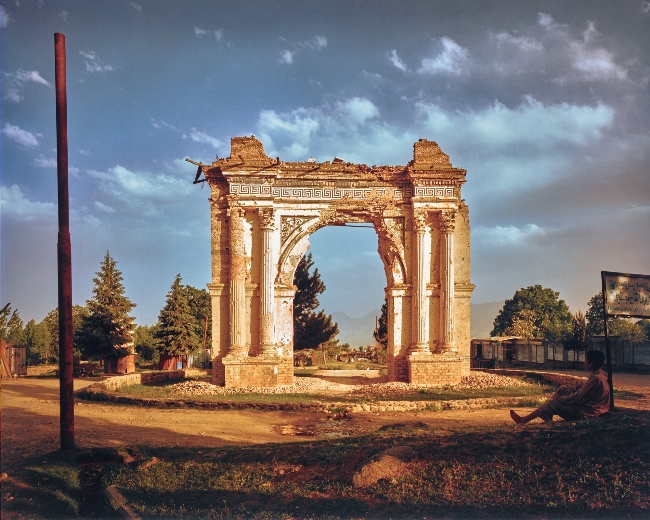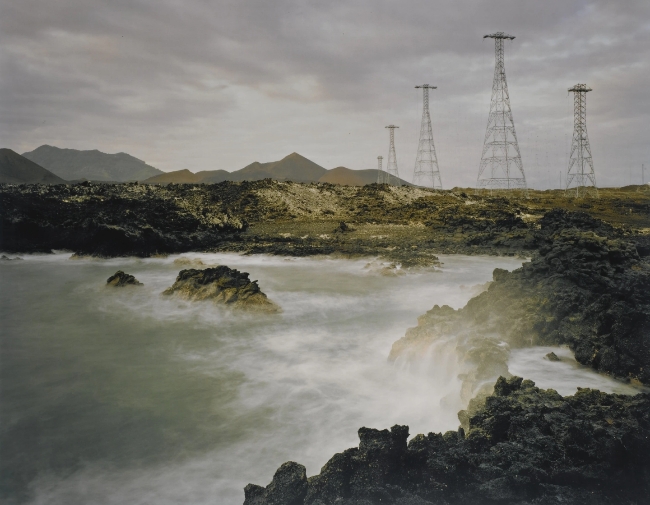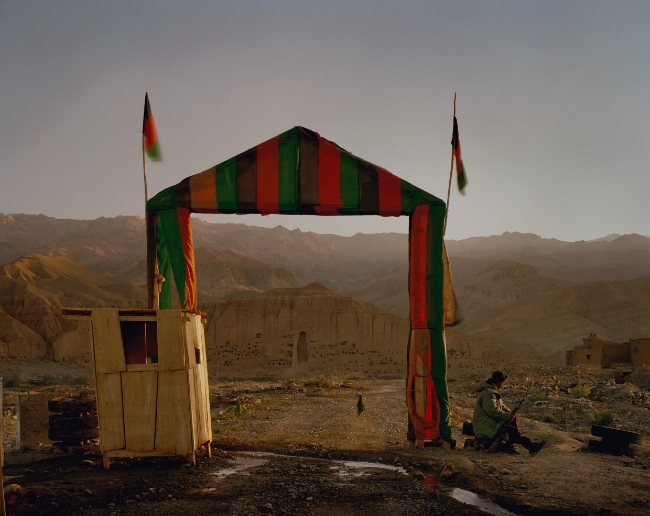In 1919, Amanullah Khan of Afghanistan led a coalition of tribes in revolt against the British, who’d ruled his nation since 1839. After the British agreed to withdraw their forces, Amanullah ordered the construction of a Victory Arch in Kabul Province to commemorate Afghanistan’s newly-won independence. The arch was designed the Greek style—a style which first appeared in Afghanistan some 2300 years earlier when the land was conquered by Alexander the Great.
Amanullah’s arch was damaged during the Soviet Union’s invasion of Afghanistan in 1979. The decade-long insurgency by the various factions of mujahideen against the Soviets caused further damage, which was aggravated during the civil war that took place between the main elements of those factions after the Soviet Army withdrew. Still more damage took place in the U.S.-led international assault on Afghanistan in 2001. A couple years later, when British photographer Simon Norfolk took the following image of the arch sporadic fighting continued in and around Kabul. It continues to this day.
This is the nature of war in Afghanistan—laminar war, layers of death and killing and maiming each laid on the preceding conflict. In fact, it’s the nature of war everywhere. War shapes the landscape. It shapes the way the land is perceived. It shapes the way the land is used. It shapes the lives of the people who occupy the land.

Simon Norfolk is using the tradition of landscape photography to make pictures of war. Not combat; combat is only the most visibly active component of war. Combat photography is kinetic, it’s about the moment, it’s about what’s taking place right now in front of the photographer. Norfolk’s interests more broad, his goals are loftier. What Norfolk is attempting to do is photograph the concept of war—the entirety of war—in all it’s many faces.
Norfolk was born in Nigeria, but educated in England. He took degrees in Philosophy and Sociology, and studied photography as well. After graduating he worked for a number of progressive publications, concentrating most of his attention on covering racism and fascist groups. In 1994 he abandoned traditional photojournalism and turned to his own brand of landscape photography.
“I didn’t get fed up with the subjects of photojournalism; I got fed up with the clichés of photojournalism, with its inability to talk about anything complicated. Photojournalism is a great tool for telling very simply stories.”
Norfolk also chose to use the instruments of landscape photography: the large format camera (in his case, a 4×5 view camera). He argued that the traditional tools of photojournalism—35mm camera, fast film, standard and wide angle lenses—are locked into a 1940s narrative. “Its job is to offer all its information instantly and immediately,” Norfolk says. Standard conflict photography is locked in the instant; Norfolk’s work is an excavation into the past. He wanted to create a different photojournalistic syntax, one that would draw the viewer in more slowly and gradually reveal layers of information.

That syntax came to revolve around a concept developed by a Russian literary theorist named Mikhail Bakhtin—the chronotope. The term literally means ‘time space’; it’s obviously derived from Einstein’s notions on relativity. Basically, it’s just an acknowledgment that matter continues to exist. For Norfolk, it’s a way to use photography to observe the layers of history that shape a structure.
Battlegrounds are chronotopes. The more violent the combat—the more sustained the fighting—the more it marks the landscape and the structures that occupy it. We look at these photographs and we not only see what the camera captured at the moment the photograph was taken, but we get a sense of the long chain of events that led to that moment.
Norfolk wants the viewer to see those layers, to be drawn in by the initial beauty of the photograph and then discover what lies beneath the beauty. “Beauty is a tactic,” he says. His images are consciously modeled after the work of Renaissance artists who frequently painted the ruins of palaces awash in dramatic golden light. Those painters weren’t just painting pretty pictures; they were making a statement about the ultimate futility and impermanence of earthly empires.
Norfolk is also making a statement, though he’s addressing the complexity of modern war. “All the work that I’ve been doing…is about warfare and the way war makes the world we live in. War shapes and designs our society.” I’m inclined to think Norfolk would have been more accurate if he’d said military technology shapes and designs our society. As Heraclitus, the Greek philosopher said, war is the father of all things.
For example, the roads built and maintained by the Roman army to enable them to move troops and supplies quickly regardless of weather have molded cities (and civil economies) from London to Trabzon. The city of Rotterdam was almost completely leveled by bombs during World War II. During the reconstruction, the city developed an architectural policy that encouraged ambitious and creative structures. In the U.S., former ICBM Atlas Missile Silos have been turned into private residences and unique conference centers. All these things were shaped by military technology.

Modern war transforms the world in less obvious ways. Much of modern war tech isn’t located anywhere near a battlefield. In the middle of the South Atlantic, halfway between Africa and South America, is a small volcanic island called Ascension Island. It’s the home of the BBC World Service Atlantic Relay Station. It’s also the home of an extensive joint U.S. and U.K. signal intelligence surveillance system. The men and women who operate the technology may not wear uniforms, but they are nevertheless key to the prosecution of modern war. Norfolk wants his viewers to be aware of that.
This is part of what Norfolk means when he argues that traditional photojournalism is locked into a 1940s narrative.
“I wonder what photojournalists of the future are going to photograph? Are they still going to photograph guys with guns, shooting at each other? Because quite soon there aren’t going to be guys with guns shooting at each other. We’re quite soon getting to the era of UAVs [unmanned aerial vehicles] and stuff. People aren’t even going to know what shot them, and there will be nothing to photograph.”
The information gathered and processed by all those towers and radar domes in the background of Norfolk’s photograph of Ascension Island is as much a part of modern war as aerial reconnaissance was during WWII, or the lone scout surveying enemy territory on horseback. The tools used to process the data gathered by those towers are radar domes are as critical as the physical maps used by generals in traditional warfare.

Those tools include the supercomputers used for military purposes—particularly those used in nuclear research—are essential to his study of war. “Those computers…are battlegrounds,” he says. They’re “designing and thinking about a space that is only about 30 centimeters across and exists for about a billionth of a second, and that’s an exploding nuclear warhead.” The Mare Nostrum (pictured above) is housed in the nave of an old church in Barcelona; it’s been used to model wing shapes for fighter jets.
Just as Norfolk’s interpretation of the subject matter of photojournalism is radically different from the traditional, so too is his approach to the work. Like a traditional photojournalist Norfolk is reporting facts, but he’s not at all objective about them. He has a definite political agenda: he is against war. His choice of tool—a 4×5 mahogany and brass field camera—is cumbersome and slow, nothing like traditional photojournalist cameras. A traditional photojournalist shoots a lot of frames; for Norfolk, “Each time I press the button it costs me about £15, so I [can’t] just go clickety-click.”
Norfolk even dresses differently. When he’s in a situation where violence is possible, he wears a loud Hawaiian shirt.
“I can’t believe that photographers go into war zones dressed like soldiers. Soldiers are the people they shoot at. If I could wear a clown suit I would do it – if I could wear the big shoes and everything. I would wear the whole fucking thing. I can either scrape in there on my belly, wearing camo, and sneak around; or I can stand right there in front, wearing a shirt that says, you know, ‘Don’t shoot me. I’m a dick.'”
One visual trope that repeats itself in Norfolk’s work is the ‘victory arch.’ We began by looking at the triumphal and ornate arch constructed nearly a century ago by Amanullah Khan of Afghanistan. We’re finishing with a less permanent arch cobbled together by some members of Afghanistan’s Northern Alliance, the coalition of Tajik, Hazara and Uzbek mujahideen who fought against the largely Pashtun Taliban following their combined defeat of the invading Soviet forces.

Seen through the arch is the empty niche which once housed one of two 6th century statues of the Buddha. The statues were destroyed in 2001 by the Taliban. They were constructed during a period when the region was ruled by the Kushan Empire—part of the Kushan effort to control trade along the Silk Road. The Kushan Empire once extended from what is now Sri Lanka to Afghanistan and to parts of western China.
Who now remembers the glorious Kushan Empire?
Much of Norfolk’s work draws on ideas originating from 17th and 18th century European landscape painters. That includes what he calls “that amazing golden light…as a photographer, I can’t invent it like a painter can; I have to take the photographs very early in the morning.” But his main lesson is what those painters understood.
“[A]ll the empires they could see being built in their own lifetimes – the British empire, the French empire, the Dutch empire – they were saying: look, all of this is crap. None of this is really permanent: all of these things rise and fall. All empires rise and fall and, in the long run, all of this is bullshit.”
Is Norfolk’s war against war effective? Does his ‘beauty is a tactic’ approach accomplish his goal? Is he able to show the scope of modern war? I’m afraid I’m inclined to answer each of those questions with ‘no.’ But he’s making a noble attempt, and his passion is obvious, and even if he doesn’t achieve what he hopes to, the effort is surely worthwhile.
